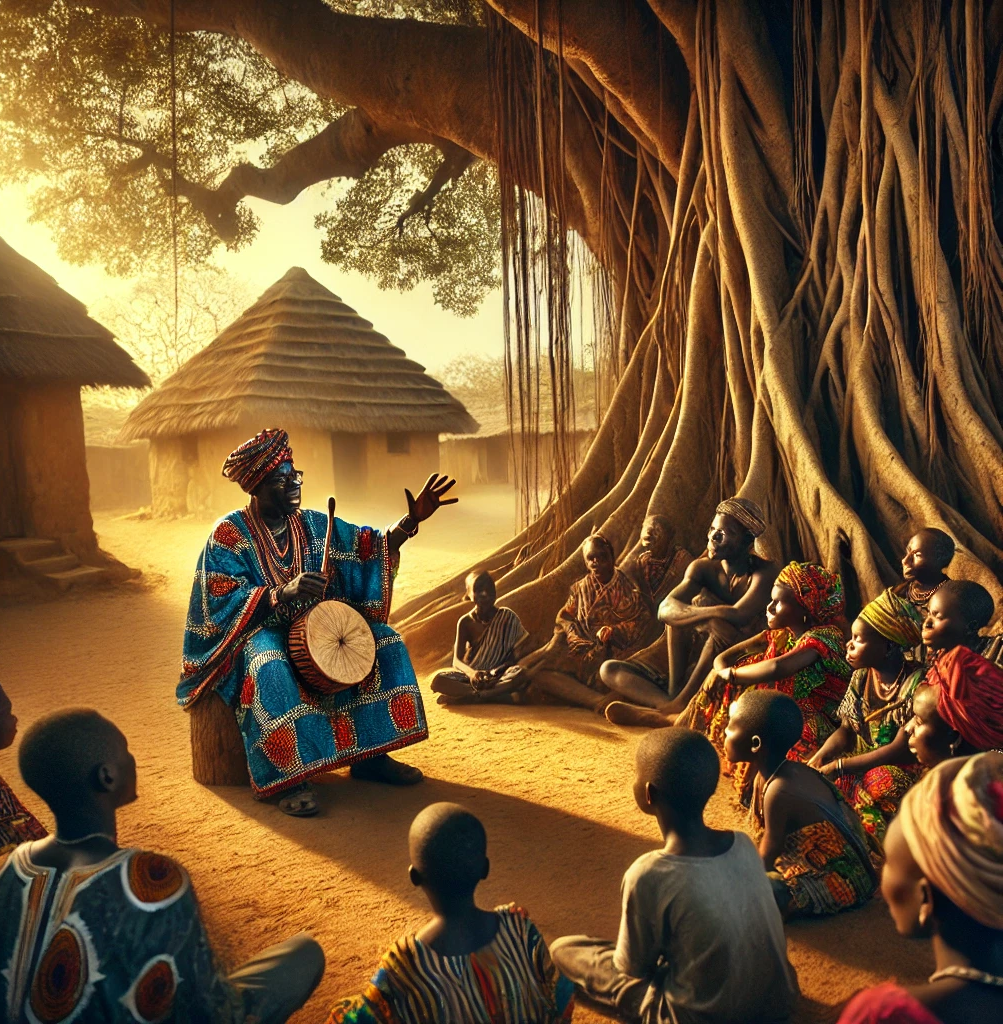“Listen, and I will tell you the story of Sundiata, the Prince of Mali. Born to a prophecy, he was weak at birth, but fate had grand designs for him. Against all odds, he rose to unite the twelve kingdoms of Mali, bringing peace and prosperity to the land. His courage, his wisdom, and his unyielding spirit live on in the hearts of our people.”
The crowd leans in, hanging on every word, their imaginations stirred by the vivid images the storyteller paints with his voice. Suddenly, he pauses, a knowing smile playing on his lips. “But who am I, you may wonder, to know such tales, to remember such heroes?”
He straightens, looking each listener in the eye. “I am a Griot,” he declares, “a keeper of memories, a guardian of our past.”
Griots are more than mere storytellers; they are the living archives of their people, preserving history through spoken word, and music. From generation to generation, they pass down the wisdom of the ages, ensuring that the deeds of the past never fade from memory.

The Origins of Griots
The tradition of Griots is very old, going back to the early days in West Africa around the 13th century. Back then, history wasn’t written down in books but shared through stories, songs, and spoken words. Griots became the special people chosen to remember and tell these stories. They had great memories, spoke well, and understood their people’s traditions and values deeply.
In the royal courts, Griots served as advisors, historians, and even diplomats. Their words carried the history of kings, the laws of the land, and the heroic deeds of warriors. This helped new rulers understand the legacy they were stepping into.
Over time, Griots also began to tell the stories of everyday people, keeping alive the memories of their struggles, joys, and achievements. Through their storytelling, Griots connected people to their past, making them essential to the cultural life of West Africa.
Why Griots Were Necessary in Times Past
In the days before written records were commonplace, Griots were absolutely essential to the survival of a community’s history, culture, and identity. Here’s why:
Preservation of Oral History:
In many African societies, history was not recorded in books but passed down orally from one generation to the next. Without Griots, these stories, which included the genealogies of families, the rise and fall of empires, and the achievements of ancestors, could have been lost forever. Griots were the living repositories of this information, ensuring that the collective memory of a people was preserved.
Education and Moral Guidance:
Griots were educators. They taught through stories, embedding lessons about morality, ethics, leadership, and social responsibility within their narratives. In a time when formal education systems were rare, Griots played a critical role in teaching the young about the values and norms of their society. Their stories were tools for imparting wisdom, shaping the character of individuals, and guiding the behavior of the community as a whole.
Recording and Transmission of Knowledge:
In times past, the ability to recall and narrate events with precision was vital for the continuity of leadership, legal systems, and social structures. Griots ensured that this knowledge was passed down without distortion, acting as the guardians of truth and continuity.
Entertainment and Social Connection:
Griots also provided entertainment, but their role was far deeper than that. Their performances brought people together, creating a shared experience that strengthened social connections. The Griot’s storytelling was a major source of joy and community spirit. Their ability to captivate audiences helped to keep traditions alive and make cultural heritage accessible and engaging.
How People Were Chosen to Be Griots
Birth into a Griot Family
The most common way a person became a Griot was by being born into a Griot family. Griot families were often recognized and respected for their knowledge, skills, and the important role they played in society. Children born into these families were expected to carry on the tradition, learning the art of storytelling, music, and history from a very young age.
Since Griot knowledge was passed down orally, young Griots would spend many years listening to and repeating the stories, songs, and genealogies that defined their culture. This repetition helped them to internalize the material, ensuring they could recall it accurately when it was their turn to perform. Over time, they would be tested on their ability to remember and recite these stories correctly.
Recognition by the Community: As young Griots grew in their abilities, they would eventually be recognized by the community as full-fledged Griots, capable of carrying out the responsibilities of the role. This recognition often came after they had proven their skills through public performances or by assisting in important ceremonies. Once recognized, they would assume their place as a respected member of the community, continuing the work of their ancestors.
Pratical Lessons from Griots
Today many African communities face a significant challenge—the loss of cultural heritage. Statistics show that a large number of African children born today are growing up without learning their native languages. Research shows that English impacts greatly on Nigerian Languages. Issues like borrowings from English into other languages eg. Igbo, yourba; predominantly occur. ~Obikwelu, E. I. (2021).
This trend is not just limited to language; traditional practices, stories, and even family histories are fading away as modern lifestyles take over. This cultural erosion is concerning because it disconnects us from our roots and the rich history that defines who we are. But there’s hope. We can learn from the Griots, the traditional storytellers and keepers of history in West African cultures, to help preserve our heritage.
To preserve our history and culture, we can bring Griot practices into our everyday lives. Here are some simple, practical ways to do this:

- Storytelling During Family Activities: Just as Griots shared stories during gatherings, we can make storytelling a part of family life. For example, a mother could tell her daughter about their family history while they cook together. These stories can include tales of grandparents, family traditions, or the origins of certain customs. This not only preserves history but also strengthens the bond between generations.
- Language Preservation: Encourage the use of native languages at home. Make it a habit to speak your mother tongue with your children, even if they are more comfortable with a different language. This practice helps keep the language alive and connects children to their cultural roots. You could also include traditional songs and poems, just as Griots did, to make learning the language more engaging.
- Documenting Family History: Take time to document your family’s history. You don’t need to write a book—start with simple things like creating a family tree or recording stories from elders on a phone. Share these stories regularly with your children, so they understand where they come from and feel proud of their heritage.
- Cultural Rituals and Practices: Incorporate cultural practices into daily life. This could be as simple as following traditional cooking methods, celebrating cultural festivals, or teaching children about the significance of certain customs. By making these practices a regular part of family life, you help ensure they are not lost over time.
- Community Involvement: Participate in community events that celebrate your culture. Encourage your children to get involved, whether it’s through performing traditional dances, participating in cultural discussions, or simply attending events in your home town. Being part of a larger community that values its heritage reinforces the importance of preserving it.
Reference list:
- Obikwelu, E. I. (2021). Language and multicultural contact: An investigation into the effect of English on Nigerian languages. ResearchGate. https://www.researchgate.net/publication/354209709_Language_and_Multicultural_Contact_An_Investigation_into_the_Effect_of_English_on_Nigerian_Languages
- https://en.wikipedia.org/wiki/Sundiata_Keita

Hello to every one, as I am truly eager of reading this blog’s post to be updated regularly.
It carries pleasant material.
Very rapidly this site will be famous among all blogging visitors, due to it’s
fastidious articles or reviews
Ahaa, its nice conversation about this paragraph at this place at
this website, I have read all that, so now me also commenting here.
Pretty! This was an incredibly wonderful article.
Thanks for providing this information.
Have you ever considered creating an e-book or guest authoring on other websites?
I have a blog based on the same subjects you discuss and would love to have you share some stories/information. I know my
visitors would value your work. If you’re even remotely interested, feel free to send me an email.
Oh my goodness! Awesome article dude! Thank you, However I am encountering problems with your
RSS. I don’t understand why I cannot subscribe to it.
Is there anybody getting identical RSS issues? Anyone that knows the solution will
you kindly respond? Thanks!!